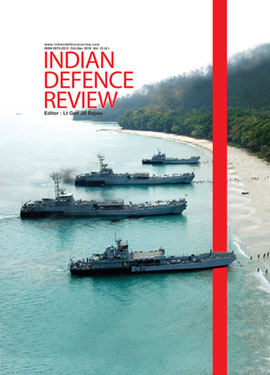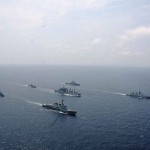While we all know that warships do not come cheap, there is an urgent need to standardise designs and review the costing mechanism to ensure realistic prices and timely deliveries, particularly with several big-ticket projects in the pipeline. In addition to construction costs, there is also the need to examine manning of ships – particularly the non-weapon intensive platforms such as the OPVs. An Indian OPV is typically manned by about 100 to 120 personnel whereas a similar vessel in most other Navies is manned by 50 to 75 personnel. In fact, as per reports, the NGOPV is planned for a complement of 150 personnel which is very high by current standards particularly with the high degree of automation envisaged. Such a reduction in complement in keeping with modern trends, will not only slash operating costs, but also reduce revenue expenditure substantially.
Approval of the long pending proposal for procurement of six Next Generation Offshore Patrol Vessels (NGOPVs) by the Defence Acquisition Council (DAC) recently, reportedly at the cost of Rs 4,941 crore brings us back to the question of costing of warships. This factor assumes great significance in the light of depleting allocation of capital budget (in real terms) and hence the necessity to get the maximum ‘bang-for-the-buck’.
So how much should a warship cost? Well, as it stands, your guess is as good as mine – going by the present trend amongst Indian shipyards! To put it plainly, the prices at which some contracts have been awarded in the recent past by the Ministry of Defence (MoD) to Indian Shipyards for building warships (all MoD ships except Yard Crafts) seem illogical. They are either unrealistically low or exorbitantly high – depending on how you view it. Either way, this trend does not portend well, since an unrealistically low bid would adversely affect deliveries and an exorbitant bid, would result in wastage of tax payers’ money.
To elaborate my hypothesis, let us take the case of the Offshore Patrol Vessel (OPV) which is the work-horse of both the Indian Navy and the Indian Coast Guard – indeed of most Navies and Coast Guards worldwide. These are typically lightly armed vessels of approximately 1200 to 2200 tonne displacement, about 75 to 100 metres long, with a maximum speed of around 25 knots and a range of about 5,000 nautical miles. Their role consists of ocean surveillance, coastal and offshore patrolling, fleet support, escort duties, search and rescue missions, monitoring offshore assets and Sea Lines Of Communications (SLOC). Some of these are also equipped to undertake pollution control and firefighting.
The costing arrived at with CGOPV cost as the basis cannot be disregarded since the L&T Shipyard has delivered ships at that cost – and on time at that…
Tabulated below are the comparative particulars of OPVs being constructed/planned for construction at Indian shipyards. These are the Naval Offshore Patrol Vessel (NOPV) being constructed at Reliance Naval & Engineering (RNEL) at Pipavav, Coast Guard Offshore Patrol Vessel (CGOPV) being constructed at L&T Shipyard (L&T), Kattupalli, Sri Lankan Naval Offshore Patrol Vessel (SLNOPV) built at Goa Shipyard Ltd (GSL) and the Next Generation OPV (NGOPV) approved by DAC on August 13, 2018.
In addition to the above features, helicopter facilities, platform and bridge management systems, auxiliary machinery, accommodation, navigation and communication suits are also similar on all the above OPVs. However, though the role and main features of the above OPVs are similar, there are some differences too. For instance, most of the equipment for the NOPV has to comply with the Naval Shock Standard II (approx. 25 per cent costlier) whereas equipment for the CGOPV need not. Also, while the CGOPVs are fitted with external firefighting equipment and bow thrusters, the NOPVs are fitted with special electronic warfare and communication equipment. Further, in the case of NOPVs, the armament supply is in the scope of the shipyard whereas in the case of CGOPVs, it is not. Therefore, if armament and special equipment cost (Rs 130 crore approx.) is excluded, the NOPV would cost Rs 370 crore. The specifications for the SLNOPV and the NGOPV would be similar to the NOPV and so would their costing not be analysed separately.
|
Table 1. Details of OPVs Under Construction |
|||||
| Sl No | Feature | NOPV | CGOPV | SLNOPV | NGOPV |
| 01 | Displacement (Tons) | 2230 | 2140 | 2350 | 2500 |
| 02 | Length x Beam x Depth (metres) | 105×12.9×3.6 | 97×12.6×3.6 | 105.7 x 13.6 x 3.6 | TBD* |
| 03 | Propulsion Power (Kilowatts) | 2×9000 | 2×9000 | 2×8000 | TBD* |
| 04 | Maximum Speed (Knots) | 25 | 26 | 24 | 25 |
| 05 | Range (Nautical Miles) | 6000 at 16 knots | 5000 at 14 knots | 7000 at 15 knots | 6000 at 16 knots |
| 06 | Endurance | 20–50 days | – | 20–50 days | 60 days |
| 07 | Power Generation (Kilowatts) | 1500 | 2000 | 2000 | 2000 |
| 08 | Complement | 118 | 90 | 118 | 150 |
| 09 | Armament | 1x76mm gun with FCS, 2x30mm CWS and 4xKawach | Provision for 1 x 30 mm Gun with FCS and 2 x 12.7 mm guns with FCS | Fitted for | TBD* |
| 10 | Year of Order | 2011 | 2015 | 2014 | – |
| 11 | Approx Cost per ship (Rs Crores) | 500 | 186 | 450 | 800 |
| Note: TBD* – To Be Decided | |||||
Assuming that the NOPV was ordered at the ‘right price’ in 2011, the material cost of NOPV would amount to Rs 241 crore (approx. 65 per cent of the ship’s cost less armament and special equipment). Similarly, through a process of extrapolation (discounting shock grading cost) the CGOPV material cost can be estimated to be roughly Rs 193 crore, i.e., Rs 7 crore more than its total contracted cost! Conversely, if it is assumed that the CGOPV has been ordered at the ‘right price’ in 2015, and the cost of NOPV reverse calculated, the same would work out to Rs 233 crore (without armament and special equipment). This implies that the ‘right price’ of NOPV should have been Rs 363 crore (including armament and special equipment) – Rs 137 crore less than the present cost!
The above costs do not factor in Exchange Rate Variation (ERV) of over 36 per cent between 2011 and 2015 which would impact the overall cost of the ships substantially. With no ERV protection in MoD orders awarded through competitive bidding, it is indeed intriguing that the contracted price of CGOPV should be almost one third that of the NOPV despite being ordered four years later!
Nevertheless, since CGOPVs are being delivered by L&T Shipyard as per contractual timelines the as-built cost can be assumed to be the contracted cost after adjustment for ERV that is approximately Rs 228 crore per ship. Using the same principle and after factoring in shock grading of machinery (less cost of armament and special equipment), the cost of the SLNOPV and NGOPV can be extrapolated to approximately Rs 270 crore and Rs 305 crore respectively. Similarly, with the cost of NOPV as the basis and after factoring in shock grading of machinery (less cost of armament and special equipment) the cost of SLNOPV and NGOPV can be extrapolated to approximately Rs 455 crore and Rs 510 crore respectively.
There have been cases where the contracted price is higher than the sanctioned cost by over 250 per cent delaying contract conclusion…
If an additional Rs 200 crore is added for armament and special equipment, the cost of the NGOPV would work out to approximately Rs 505 crore and Rs 710 crore respectively using costs of CGOPV and NOPV as the basis. While both these costs are lower than the sanctioned cost of NGOPV, i.e., approximately Rs 800 crore per ship, it is also clearly evident that there is a very wide variation in cost per ship depending on the basis adopted for costing. In fact, the costing arrived at with CGOPV cost as the basis cannot be disregarded since the L&T Shipyard has delivered ships at that cost – and on time at that.
The cases of OPVs highlighted above are not aberrations, and if one were to analyse cases of the Fast Patrol Vessels (FPV), Training Ships and some special purpose ships ordered in the recent past, the findings would not be much different. One of the primary reasons for this phenomenon is difficulty in benchmarking prices due to non-standardisation of designs and consequent lack of price discovery. There have been cases where the contracted price is higher than the sanctioned cost by over 250 per cent delaying contract conclusion. In mature shipbuilding nations, bids outside the five per cent band with respect to the benchmark price are normally discarded. This helps in conclusion of contracts at the right price and inculcates a modicum of fiscal discipline. But unfortunately, in our system, the ‘Lowest Quotation’ syndrome reigns supreme.
These constraints, however, do not apply to public sector shipyards in respect of nominated orders. Contract price for nominated orders are finalised through negotiations between the MoD and the concerned shipyard. These shipyards are not only protected against ERV but also allowed price escalation during construction, through renegotiation at times by over 250 per cent. The Shivalik, Kamorta and Kolkatta Classes are some examples in this regard. Non finalisation/freezing of designs prior to commencement of construction and revision of designs during the course of construction are the main reasons for such cost escalation. Such changes and revisions have a huge impact not only on delivery timelines, but also financial management of the project besides adversely affecting fiscal planning under capital budget.
In the case of frigates being constructed under Project 17A at a whopping cost of Rs 6,400 crore per ship (equivalent to 34 CGOPVs) and almost 50 per cent higher than frigates under Project 17 (Shivalik Class), while the weapons/sensor package, speed, range and complement remain more or less the same, the overall dimensions and design of the platform are different. This would necessitate fresh detailed designs and production drawings leading to cost/time overruns. Therefore, the rationale for going in for a new design with totally different dimensions is unclear particularly since the weapons/sensor package, which comprises the essence of the ship, is almost the same. Perhaps it would have been better to go in for series production of the Shivalik class with incremental improvements as is the practice in almost all developed countries so that reduction in costs and build times could be achieved by leveraging the advantages of standardisation. Arleigh Burke Class destroyers (65 ships) and Oliver Hazard Perry Class Frigates (71 ships) of the US Navy as well as the Leander Class of the Royal Navy (26 ships) are a few examples in this regard that readily come to mind.
While we all know that warships do not come cheap, there is an urgent need to standardise designs and review the costing mechanism to ensure realistic prices and timely deliveries, particularly with several big-ticket projects in the pipeline. In addition to construction costs, there is also the need to examine manning of ships – particularly the non-weapon intensive platforms such as the OPVs. An Indian OPV is typically manned by about 100 to 120 personnel whereas a similar vessel in most other Navies is manned by 50 to 75 personnel. In fact as per reports, the NGOPV is planned for a complement of 150 personnel which is very high by current standards particularly with the high degree of automation envisaged. Such a reduction in complement in keeping with modern trends will not only slash operating costs but also reduce revenue expenditure substantially.





